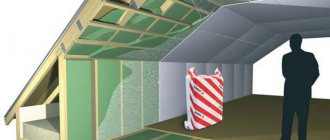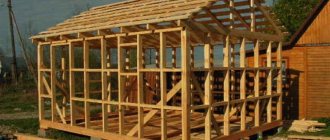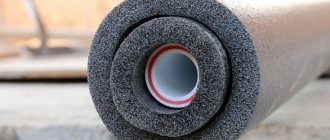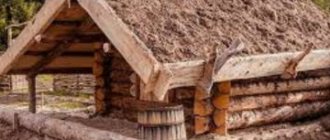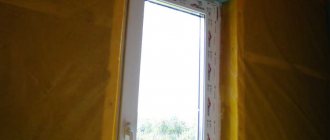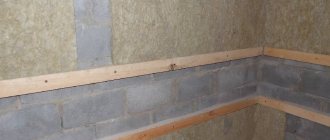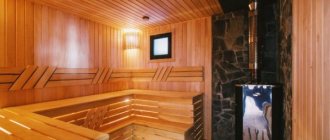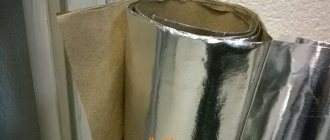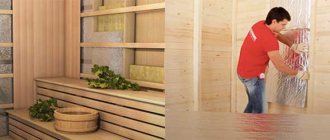Why insulate the floor
Thermal insulation layer is necessary to prevent heat loss from the room. The microclimate in the bathhouse is characterized by high humidity and temperature. In the absence of proper insulation, several problems arise in this case:
- The heat quickly escapes. It becomes difficult to light the sauna. At the same time, the consumption of firewood or other fuel increases significantly. Carrying out all the necessary measures during construction will save money.
- The material of supporting structures is exposed to simultaneous moisture from the inside and cold from the outside. This combination has an extremely negative effect on both concrete and wood. In this case, operating costs increase again, but due to repair costs.
- The bathhouse cools down quickly. Drafts may get inside. Cold air causes spoiled rest or illness.
Proper insulation of the floor in a bathhouse with your own hands allows you to prevent problems, ensure an optimal indoor microclimate and not spend money on the services of professionals.
What materials to use
Water will become a problem when insulating the floor. Many materials are not designed for installation in conditions of high humidity. This applies to insulation with high absorption capacity.
For example, it is not allowed to use mineral wool to perform the work. This effective insulation is able to absorb water. When wet, cotton wool stops performing its intended tasks, wrinkles, settles and loses its shape.
For wet rooms, it is recommended to choose materials that are resistant to moisture. These include:
- Styrofoam;
- extruded polystyrene foam (or penoplex);
- penoizol, etc.
Styrofoam balls do not absorb moisture, but be aware that water can accumulate in the spaces between them. In the first winter, the insulation crumbles into individual particles. This is caused by the fact that water freezes inside the foam, expanding in volume (it is the only substance on the planet that expands when cooled).
To prevent problems, insulation of the floor in a bathhouse with foam plastic is carried out using additional materials:
- Vapor barrier. Mounted on the warm air side. Prevents the effect of steam from the bath on the insulation. Available in the form of films or membranes. To more effectively retain heat in the bath, special foil membranes are used. They not only protect the foam from getting wet, but also reflect heat back into the room.
- Waterproofing. Fixed on the cold air side. Prevents atmospheric or ground moisture from entering the insulation. Films and membranes are used as a hydrobarrier. To insulate the floors in a bathhouse on stilts, moisture- and wind-proof membranes are chosen. They prevent drafts.
The material is a close relative of foam plastic, but without its disadvantages. It costs more, but is distinguished by high strength, quality and resistance to moisture. The thermal insulation properties of these materials are the same.
The choice between them is made depending on the installation method and the expected load. When installing heavy furniture and laying insulation under the screed, extruded polystyrene foam is preferred. It definitely won’t wear out under load (if you choose the right brand for strength).
Insulating the floor in a bathhouse with penoplex allows you to do without vapor barrier and waterproofing. They should be used whenever possible (especially in areas with the highest humidity), but this is not a necessary step.
Insulating a bathhouse from the inside with your own hands (thermal insulation) - Construction
The general concern of the population about their health has led to the fact that almost every owner of a country house strives to acquire a bathhouse. The specificity of this useful structure is thermal procedures that require the creation of a consistently high temperature in the steam room. To ensure a similar microclimate with the least amount of energy spent, something like a thermos is installed inside the building. The insulation of a bathhouse can be carried out using different materials, which directly affects the method of implementation.
Insulation can be carried out using various materials and methods
Why is thermal insulation needed?
The bathhouse has many useful properties, but many of them may not be available if the internal insulation is not properly organized.
In such a situation, even competently implemented construction work will not save you: if the walls of the building are not able to retain the heat created by the stove, the comfort of taking bath procedures will noticeably drop.
The only way out is to reduce the time between kindlings, which, accordingly, will provoke an increase in financial costs for paying for energy resources.
A more correct solution is to insulate the bathhouse; fortunately, there are a number of effective technologies for this. It is best to do this during the construction of the building.
However, if this important stage was missed for some reason, some methods of internal insulation can be implemented after construction is completed.
The main difference between thermal insulation of a bathhouse and a similar procedure in an ordinary house is that in the first case, it is necessary to maintain the high temperature created by the stove for as long as possible inside the room. This requires a better approach to carrying out work.
Good thermal insulation means maximum energy efficiency of steam rooms and baths
Which material is better
In the old days, insulation of baths was carried out exclusively with natural materials. We are talking about felt, hemp, flax, red moss, etc. The undoubted advantage of these insulation materials is their complete harmlessness to people. Even under conditions of a significant increase in temperature (which often happens in a steam room), they do not emit any harmful substances or toxins.
Natural materials also have significant disadvantages:
- The complexity of the installation process. Despite the simplicity of the procedure for caulking a bathhouse using moss or tow, it takes a lot of time and effort. As a result, we have to increase payments to craftsmen.
- Weak biological resistance. Natural materials are susceptible to rotting and fungus formation: in conditions of constantly high humidity, this only gets worse. Insects and rodents often live in the thickness of the insulation, so regular inspection and refilling of the thermal insulation layer will be required.
Modern artificial insulation materials have more attractive performance characteristics.
Modern insulation materials
Although their degree of environmental friendliness is somewhat lower, their service life is an order of magnitude longer. This is explained by their absolute inertness with respect to constant moisture and high temperatures.
If we add here low weight, ease of installation and low cost, it becomes clear why synthetic materials have now practically replaced natural analogues. The most commonly used materials are polystyrene foam, basalt fiber, mineral wool and glass wool.
Before insulating a bathhouse from the inside, you need to familiarize yourself with the characteristics of each of these materials.
Expanded polystyrene
It has excellent thermal insulation characteristics with low weight and low cost.
Expanded polystyrene foam resists moisture well, but in high temperature conditions there is a real risk of deformation and even fire of the slabs.
If we add here the release of toxic substances when heated, it becomes clear why they try not to use this material in baths (except for the external design of the dressing room).
Expanded polystyrene is a close relative of polystyrene foam, but with improved characteristics
Basalt fiber
An excellent option for insulating a bath. The raw material for the production of basalt fibers is molten rocks.
This explains the following characteristics of the material:
- It doesn't burn at all.
- Tolerates mechanical stress and high humidity well.
- Has the ability to absorb noise.
- Provides excellent thermal insulation.
- Can be used for decades without loss of performance characteristics.
Installing basalt insulation is very simple, because... it can be cut into pieces of the desired size. The only drawback of this material is its high cost.
Basalt fiber compresses well, and after installation it occupies the entire required volume. On our website you can familiarize yourself with the most popular bathhouse projects from construction companies presented at the exhibition of houses “Low-Rise Country”.
Mineral wool
It is produced under approximately the same conditions as basalt fiber. The difference between them concerns the raw materials used: in this case, it is not rock, but metallurgical waste. In this way, it is possible to significantly reduce the cost of the finished material.
https://www.youtube.com/watch?v=0ynvd6p8CzM
In addition to being cheap, mineral wool has other advantages:
- Low level of thermal conductivity. Thanks to this, the heated room retains its heat for a long time.
- Moisture resistance. The material can be used at consistently high humidity.
- High sound insulation performance.
The disadvantages of mineral wool include its low resistance to mechanical stress. This introduces certain difficulties into the installation procedure.
Mineral wool is offered in slabs or rolls
Glass wool
The material consists of the finest threads of inorganic glass intertwined. As a result, numerous air layers and pockets are formed inside the glass wool, preventing heat from escaping through the thickness of the insulation.
You should also highlight the good vapor permeability and low cost of the material. It is available for sale in rolls of different thicknesses and widths, which makes it easier to select the optimal level of insulation. In addition to rolls, glass wool is sold in the form of mats and slabs.
Work with glass wool is carried out in protective clothing
What to choose
An analysis of the characteristics of materials for thermal insulation leads to the conclusion that the best option for insulating a bathhouse from the inside is basalt fiber and mineral wool. To save money, the choice is mainly made towards mineral wool. Moreover, manufacturers managed to solve the problem of its fragility through the use of foil.
Insulation under the screed
If the bathhouse is built of brick, most likely the ceilings are made of reinforced concrete. Also, sometimes there is a need to make a floor on the ground. In this case, insulation is performed under the screed. When using this technology, the load on the insulation increases, so you should follow the following recommendations:
- choose material grade PSB-S 35 (foam plastic) or EPPS 35 (penoplex);
- the thickness of the screed is prescribed 30-50 mm (when using the “warm floor” system - more);
- when using polystyrene foam, the screed is reinforced with wire mesh with a diameter of 3-4 mm and cells of 50 by 50 mm.
If it is necessary to insulate the floor on the ground, then the base is not only leveled, but also compacted. The floor pie in this case looks like this:
- compacted soil;
- sand-gravel mixture or medium-sized sand (20-30 cm);
- concrete preparation from lean concrete B7.5—B12.5;
- waterproofing;
- insulation;
- vapor barrier;
- screed with reinforcing mesh.
The concrete floor consists of the following layers:
- reinforced concrete slab;
- waterproofing;
- insulation;
- vapor barrier;
- screed (with or without reinforcement).
Insulation of a bathhouse begins with clearing and leveling the base. All cracks in the concrete floor must be covered with cement mortar. After this, special leveling mixtures can be used. A line is drawn on the wall to mark the finished floor. This is required in order to control evenness.
Waterproofing is placed on the prepared base. It is mounted with an overlap of 10 cm (including on walls), gluing the joints with a special film.
Polystyrene foam or polystyrene foam is laid on glue. The solution is applied only along the edges and to several points in the center. When purchasing glue, it is important to check that it does not contain solvents or other substances hazardous to the insulation. The slabs are installed with the seams bandaged (in a staggered manner). A gap of 1-2 cm is provided between the polystyrene and the wall, taking into account the expansion of the material during operation; this space is filled with damper tape. Before pouring the screed, the slabs are secured to the base using disc dowels.
Installation on joists
Insulation of the floor in a bathhouse on screw piles (or for a wooden structure on any foundation) is most often carried out between joists or beams. Unlike the previous method, here you can choose insulation with less strength, since the material does not take the load from furniture and people.
Expanded polystyrene is mounted between wooden floor joists or between floor beams. The floor pie for a wooden bath in this case looks like this:
- subfloor boards (or plywood, DSP, OSB);
- waterproofing;
- insulation between load-bearing wooden beams;
- vapor barrier;
- clean floor.
The insulation is simply laid between the beams. There is no need to use glue or dowels. But it is necessary to fill the gaps between polystyrene and wood with sealant or polyurethane foam.
Proper insulation of the bathhouse will ensure a comfortable microclimate and extend the service life of the building. An increase in construction costs in this case leads to savings in operation.
Insulation of the floor in the bathhouse - implementation options
Insulating the floor in a bathhouse with your own hands is very important.
Work process photo
To underestimate this part of the arrangement of the premises means finishing the work poorly, since then you will be haunted by two problems:
- Heat loss through a floor surface with high thermal conductivity. Consequently, the cost of heating the steam room will increase significantly.
- The burning contrast of the cold floor and the surrounding hot air. This is not only discomfort for your body, but also subsequent condensation, which can lead to mold and rotting of the boards.
Floors can be concrete or wood. Based on this, we will consider the most convenient ways to insulate them.
Concrete floor
Insulation of the concrete floor in the bathhouse occurs after the construction of the entire building.
Tip: it is recommended to use materials with high compressive strength, since the installation of a reinforced grating and a layer of cement screed will follow on top.
To achieve a high-quality effect, you can use the following materials:
Insulating layer made of expanded clay
This material is made by short-term firing of low-melting clay. The technical characteristics of expanded clay allow its use in both concrete and wooden coverings. And the low price is an additional argument in its favor.
To ensure high-quality installation of this insulation, the following instructions will help you:
- We calculate the approximate load on the base in order to know the required thickness of the future insulating layer.
Advice: never mix expanded clay with concrete. Cement does not have such low thermal conductivity and moisture resistance, so the final result will be compromised.
- We lay a layer of waterproofing. A polyethylene film three millimeters thick is ideal, and at the joints we fasten it with mounting tape. We draw out the edges so that they lie on the wall. After filling the insulation, all excess is cut off.
Tip: It is recommended to use heterogeneous material with the presence of large and small granules. This will increase the level of grip.
- We install a reinforced grating on top and fill it with cement mortar.
- After complete hardening, the insulated floor in the bathhouse is ready for use.
Glass bottles
Folk method of insulation
This is the cheapest insulation of floors in a bathhouse, since it does not require the purchase of the insulation itself. You just need to collect the spent empty bottles. In addition, not only glass, but also plastic eggplants are suitable.
The trick is that we will create a warm, sealed air cushion in the concrete surface.
Installation of this design is also simple:
- We wash and thoroughly dry the prepared containers.
- We lay them on a base prepared for concrete screed.
- Fill everything with liquid cement mortar so that it covers the walls of the bottles.
- On top, after drying, we apply a finishing screed from a more durable mixture.
Laying foam insulation layer
This material has a number of remarkable qualities, thanks to which it is used not only for insulating the floor, but also the walls and ceiling of the bathhouse:
- Low price. Not as low as when using essentially discarded bottles, but much lower than many other insulation materials.
- High heat-saving properties due to the presence of many air bubbles in its structure.
- Noise insulation.
- Fire safety. It is a self-extinguishing substance and does not release toxins during combustion.
- Service life more than fifty years.
- Absence of rotting processes, shrinkage and other age-related deformations.
- Ease of installation, which is greatly facilitated by the light weight of the material.
Installs equally well under the screed and under the boards:
- Layer of waterproofing layer.
- We lay foam plastic slabs on top of it in a checkerboard pattern. This will make the design more reliable.
- We close the gaps with polyurethane foam or waste material.
- We install a metal grating and pour a cement screed.
- The hardened floor can be put into operation.
Bathhouse made of boards and insulation
Frame construction technology came to Russia from the West. The conceptual difference in the approach to the construction of buildings for a long time did not allow the technology to gain a strong position, and was considered as prefabricated temporary housing and auxiliary buildings.
However, over time, more and more attention began to be paid to the frame construction technique. Previously built houses have shown reliability and durability. The speed of construction, low demands on the quality of the foundation due to its low weight, and good heat conservation of houses have made this method of construction popular and widely known.
A bathhouse built using frame technology is not inferior in quality to more expensive building options (for comparison, read about logs or beams, as well as about bathhouses made of foam blocks), despite the fact that in addition to saving on the construction of the bathhouse itself, there is a significant gain on the foundation. In practice, it has been found that the biggest calculations are caused by the roof of the bathhouse; care must be taken that it does not turn out to be overly heavy. Light walls are unsuitable for heavy loads, and the weight of the roof must correspond to the capabilities of the walls.
The wall of a frame bath is a wooden frame, the voids of which are filled with insulation, lined with sheet materials or clapboard. This design stores heat well, does not require heating costs, is easy to repair, and local and spot repairs are allowed.
The advantages also include the almost absolute absence of shrinkage, which allows for final finishing immediately during construction. The requirements for the composition of the walls are moisture resistance and the absence of release of toxic substances when heated.
Advice! You should also carefully monitor fire safety, since the traditional source of heat in a bathhouse is a stove, an element that is risky in itself. Therefore, it is advisable to use non-flammable and non-toxic materials when insulating.
Pie wall frame bath
The multi-layer construction of walls with insulation, vapor barrier or, as an option, a multifunctional membrane, has received the name “pie” among experts. The construction of such a pie is the main reason for the abundance of advantages and useful properties of frame walls.
Wooden floors
Insulation of a wooden floor in a bathhouse is even less demanding than in the case of concrete. In addition to the unusual bottle method, all insulation materials used in cement pavement can also be used under boards.
This is due to the installation technology:
- We install wooden logs on the rough prepared base.
Insulation of a wooden underground
- We lay insulating material between the joists. This can be expanded clay, polystyrene foam, mineral wool, penoizol, polyurethane, etc.
- We install waterproofing to protect against possible moisture ingress from above.
- We install the boards, fixing them with nails to the joists.
Separately, you should consider insulation such as mineral wool, which is not suitable for lining under a concrete layer, but shows itself perfectly in a wooden structure:
- The lowest thermal conductivity coefficient is about 0.04 W/mK.
- Non-flammability. Not afraid even of open fire sources.
- Inert to household chemicals.
- High sound insulation.
- Ecological cleanliness. This material is made from rock minerals, which makes its use absolutely harmless.
- Durability. It is not subject to rotting, corrosion, attack by pests and mold.
Why is thermal insulation made?
Do you need to insulate floors? Insulation of the base is an important component of insulation work in a bathhouse. The stability of the temperature regime in the wash room, dressing room, steam room, etc. will depend on the quality of the floor insulation in the future. Water has high thermal conductivity and therefore tends to cool quickly. To prevent a sharp drop in temperature in a log or brick bathhouse, the base is insulated using non-hygroscopic materials.
Why are timber houses insulated? Reducing heat loss in wet rooms is equally important for both a wooden and a brick house. Why? The bathhouse is one of those types of buildings where a high temperature must be constantly maintained.
Since the humidity level in it is always quite high, when it comes into contact with a cold floor, the water will quickly cool, which will lead to a general decrease in the temperature in the room.
Underfloor heating system
Another option for insulating the flooring in a bathhouse is installing a heated floor system. In this case, you can choose a design based on electric heating elements or water pipes.
Such floors can not only make the floor warm, but also heat the entire room. Therefore, if they are used in a steam room, they can participate in creating the necessary environment. Their location in other rooms of the building will make it possible to move comfortably barefoot.
They are installed in the same way as other insulation materials under reinforced lattice and screed in a concrete floor and between joists under boards in a wooden floor. An important addition is the need to install heat-insulating material under the system to prevent heat loss into the ground.
Steam room floor
Flooring options
High-quality thermal insulation of a bathhouse, in addition to other operations, also includes floor insulation. At the same time, thermal insulation technology and requirements for it depend primarily on the design of the floor covering. That is why there is no single algorithm for work here, and we will have to independently choose the option that suits the existing conditions.
Leaky floor design
First, we need to decide what type of floor we will install in each of the bathhouse rooms.
The floors here are divided into two large groups:
- Leaking ones are almost always planks or slats, with gaps of about 10 mm between the individual elements of the floor covering. The features of such structures are obvious from the name. Once on the floor, water flows between the slats and ends up either on the ground or on a special concrete base that provides drainage.
It is most convenient to fix a leaking floor in a bathhouse on stilts. The base is raised above the surface, and we do not have to waste time and effort on installing a water drainage system.
Solid floor scheme
- Non-leakage (solid, solid). The flooring is either boards or ceramic tiles. In the second case, the floor is laid on top of an insulated screed with a slight slope, and a drain hole is made in one of the corners or in the center of the room. This hole is connected to the drainage tank (septic tank, cesspool, collector) using a pipe laid through the foundation/basement.
Decorative design of leaking coating
Floors of the first type are most often installed in small summer baths. Their advantage is simplicity of design. On the other hand, water drainage directly through the covering of floor slats makes high-quality thermal insulation impossible, so heat loss in such a room will be significant.
Continuous plank covering
A non-leakage floor is more difficult to install, since it needs to be made sufficiently airtight. At the same time, thermal insulation material can be placed under the waterproofing layer. Thanks to this, heat loss through the floor is minimized. In addition, the level of comfort in the lower, coldest layer of air increases.
Which option, which room should I choose?
The choice of floor type is determined by the configuration of the bath itself:
- If the washing room is connected to a steam room, then the best option would be to install a leaky floor.
Leaking floor in the steam room
- In case of separated rooms, it is better to make a washing room with a non-leaking tile floor, and a steam room with a solid floor covering made of solid boards or also made of tiles.
For a sauna with relatively dry air, the requirements for moisture resistance of the coating are lower than for a Russian bath, but still there is no alternative to these two materials.
Non-leakage flooring option for shower/washroom with drain hole
- An insulated solid floor is laid in the dressing room, locker room and other rooms. Any materials with sufficient moisture resistance can be used as flooring, but I prefer solid wood flooring.
- Also in the dressing room or rest room you can have a warm floor with water or electric heating. This solution will not be the most economical, but at the same time we will feel much more comfortable!
A water floor is well suited for heating a dressing room
Polystyrene foam as insulation: pros and cons
Foam plastic is loved by users not only for its good thermal insulation properties. It has a number of advantages:
- long service life (under good conditions up to 50 years, with temperature changes of 20);
- high hydrophobicity (does not absorb more than 0.2% moisture per day, one might say, a good waterproofing agent);
- does not emit toxic fumes and is not destroyed at temperatures of -60 - +95°C.
- safe, as it is approved in the food industry for packaging some food products and for making toys for children;
- price, but you should be wary if they offer to purchase a very cheap option;
- does not create an environment within itself for the development of various microorganisms, does not rot;
- easy to install, as it is light in weight and easy to cut.
But despite all the good looks, polystyrene foam has a number of disadvantages that manufacturers are constantly struggling with:
- highly flammable;
- when ignited, releases toxic fumes;
- crumbles;
- mice love to live in the material;
- does not allow air or steam to pass through.
Indeed, when burned, the material emits fumes that are harmful to humans. But manufacturers claim that modern material is made with the addition of a special fire-resistant substance, which helps it become self-extinguishing. It can ignite spontaneously only at a temperature of +420 °C; for example, spontaneous combustion of wood begins at a temperature of +270 °C.
Insulating a bathhouse with foam plastic is not as scary as it seems at first glance.
Harmful substances are released by the material when it melts, and not when heated in a bath. It is difficult to answer whether the manufacturers are telling the truth, and how to distinguish modern material from old batches. But practice has shown that insulation can be used for some parts of the bathhouse.
Foam insulation
Using polystyrene foam as insulation is very effective: this material does not absorb moisture and retains its properties for a long time. It is well suited for brick baths that absorb moisture from the outside and from the ground. Foam slabs are lightweight and do not weigh down the floor and foundation. When working with polystyrene foam, there is virtually no waste, which reduces the cost of production.
Stages of work
Insulating the floor with foam plastic in a bathhouse takes place in several stages:
- a foundation is laid on which the floor slab is installed;
- the floor is waterproofed;
- foam boards are laid, and a screed is laid on top;
- The screed is coated with glue with the effect of a warm floor, and ceramic tiles are laid on top.
The thickness of the heat-insulating layer is 15 cm, but for a poorly insulated bathhouse it is recommended to lay materials 25 cm thick.
Is it possible to insulate a bathhouse with foam plastic and how?
You can use insulation to insulate some parts of the bathhouse. But you should refrain from insulating the steam room with it, since the temperature in it can rise to 95 ° C, and in the sauna even higher. And foam plastic can begin to collapse at temperatures above +95 °C, so even 90 °C will be critical for it.
It is not recommended to use polystyrene foam to insulate wooden baths from the inside; the fact is that the walls will be insulated from heat and the dew point will shift between the insulation and the wall. This will lead to premature rotting. Therefore, insulation is carried out only on the outside or along internal partitions.
According to user reviews, the bathhouse, insulated from the outside with polystyrene foam, has become more comfortable, the temperature in it quickly rises and in winter does not drop below +10. The only thing you should not forget about is the vapor permeability of the foam. To prevent the walls from getting wet, it is necessary to install a ventilation system in the bathhouse.
We recommend insulating baths made of stone, brick or blocks with foam plastic. Wood itself is a good heat insulator. Moreover, a wooden bathhouse is capable of accumulating heat, that is, accumulating and retaining it for a long time.
Which parts of the bathhouse are advantageous to insulate with foam plastic?
Since polystyrene foam is not only a good heat insulator, but can additionally protect the surface from moisture, it is often used to insulate the foundation of a bathhouse.
How to insulate the foundation of a bathhouse?
Polystyrene foam is excellent for foundation insulation. But we must not forget that the insulation crumbles and is afraid of mechanical damage. To protect it from the outside, it is necessary to make a protective partition from boards or bricks.
Foam plastic is optimal for insulating the foundation. It does not allow water to pass through and the foundation will be reliably protected.
Polystyrene foam has proven to work well as insulation for the foundation of a sauna on loamy and clay soil. Since moisture does not get inside the material, it will protect the base of the bathhouse from moisture and heaving in spring and winter. But you should not use insulation when the groundwater level is higher than usual and flooding cannot be avoided. Moisture getting under the foam cannot evaporate and the foundation will begin to collapse.
The thickness of the foam for insulating the foundation of a bathhouse is chosen according to your region, so for the middle part of Russia 50 mm is suitable. In the corners of the structure, thicker material of 100 mm is used, since heat loss in the corners is the highest.
Progress of foundation insulation work:
The foundation is first excavated and cleaned of dirt. Apply a primer made of bitumen mastic and a waterproofing agent, for example, liquid rubber, to the wall. The coating is left to dry for 1–2 hours.
The foam is attached directly to the foundation wall using bitumen mastic or a polymer-based adhesive. The slabs begin to be laid from below, and they must rest on a hard base. If the foundation is just being built, then a protrusion is specially left for the foam slabs. For the old foundation, gravel is added on which the slab will rest.
The joints and the part that is glued are completely lubricated with bitumen mastic. On sale you can find foam boards with an L-shaped lock. These are easier to glue together and the protection will be more airtight.
When the slabs are laid, they are once again covered with bitumen mastic and a protective partition is made. It's easier to install boards, but they will rot quickly, so use brick. A half-brick wall is made from it along the entire foundation. Among modern materials, geotextiles have performed well. It is simply rolled out along the foam and the protection is ready. But the price of geotextiles is high.
The entire structure is buried on the side with soil and a concrete blind area is made on top. Making such insulation is labor-intensive, but the bathhouse will be protected reliably.
Is it possible to insulate a bathhouse with foam plastic floors?
Since polystyrene foam does not absorb moisture, it is often used to insulate floors in saunas. If you close the material in a screed, there will be no mechanical effects on it, and the floor will be warm.
Insulation under concrete screed
Part of the soil is removed and a sand cushion of 10–15 cm is filled in. It is leveled and compacted. Then gravel is poured, which must be hammered into the sand. Next, cover with PVC film or roofing felt, they will serve as a waterproofing material.
It is not difficult to insulate floors in a bathhouse under a screed with polystyrene foam, but the result is a structure with high heat-insulating properties.
Next, foam boards are laid, which are coated with bitumen mastic. A PVC film is again laid on top of the foam and a reinforced mesh is laid. The base for the concrete screed has been assembled.
Insulation of a frame bath begins with a vapor barrier
Metal foil - creates the effect of a thermos, combines the functions of insulation and reflector, and does not allow water to pass through.
- Ruberoid - has a low cost, but due to its heavy weight it is inconvenient to install. It is good as an addition to insulation, but when heated it emits an unpleasant smell of melted resin.
- Parchment is harmless, does not emit odors, but has low strength. During installation, it often breaks, which cannot but affect the quality of waterproofing.
- Polyethylene film is the most common and inexpensive way to protect against moisture. Despite its large dimensions, it is light in weight and has a flexible structure, which greatly facilitates installation when covering large areas.
- Foil does not allow water to pass through. Adds additional points to the insulation coefficient and creates the effect of a thermos.
Before you start work, you need to know how to properly insulate a frame bath in order to do it efficiently. Regardless of which material was chosen as insulation, when laying it in the cells of the frame, it is necessary to ensure reliable vapor barrier (for more details: “Vapor barrier of a bathhouse - selection of material and its installation”).
If you do not cut off the insulation from the bathhouse atmosphere with its high humidity, it will absorb water as the steam cools, which will certainly lead to the most undesirable consequences:
- a wet thermal insulator will significantly increase its own thermal conductivity and heat will quickly move from the room to the environment;
- the porous structure will not allow the material to dry quickly, which means mold may appear and the frame of the building will begin to rot.
Thus, when a frame bath is made, the walls are insulated using high-quality vapor barrier.
To do this, experts recommend using one of the following materials:
- aluminum foil will not only protect the insulation from moisture, but will also reflect thermal energy;
- polyethylene film;
- glassine is environmentally friendly and inexpensive.
It is undesirable to use roofing felt, as it begins to smell unpleasant when heated. When installing a vapor barrier, you should not allow even the slightest gaps to remain between pieces of material. The tightness of the joints is ensured using metallized tape, or by overlapping adjacent sheets.
Thus, when a frame bath is made, the walls are insulated using high-quality vapor barrier.
